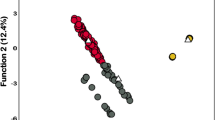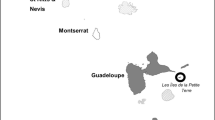Abstract
Hawaiian ducks (Anas wyvilliana), or koloa, are endemic to the Hawaiian Islands and are listed as a federal and state endangered species. Hybridization between koloa and introduced mallards (A. platyrhynchos) is believed to be a primary threat to the recovery of koloa. We evaluated the utility of two sets of nuclear markers (microsatellite loci and amplified fragment length polymorphisms) and a variable portion of the mitochondrial DNA control region to distinguish among koloa, mallards, and hybrids. We show that microsatellite and AFLP markers can be used to distinguish between koloa and mallard-koloa hybrids with a high degree of confidence. For all but one of the putative koloa in our sample, the posterior probability of belonging to the koloa category was >0.90. Similarly all but one of the mallard-koloa hybrids were assigned to the hybrid category with posterior probabilities >0.98. Subsets of markers led to poorer resolution among koloa, mallard and hybrid categories. Among a sample of 61 koloa, hybrids and mallards, we found 25 different mtDNA haplotypes, belonging to two groups of haplotypes (A and B) identified previously in mallards and their relatives. All putative koloa samples exhibited group B haplotypes, of which 65% comprised one haplotype, while the rest were divided among four haplotypes. All Hawai’i mallard samples exhibited haplotypes that belonged to group A. Hybrids and California mallards exhibited haplotypes belonging to both groups, but a majority were of group A, suggesting that hybridization may more commonly involve mating between Hawai’i mallard females and koloa males.



Similar content being viewed by others
References
Allendorf FW, Leary RF, Spruell P, Wenburg JK (2001) The problems with hybrids: setting conservation guidelines. Trends Ecol Evol 16:613–622. doi:10.1016/S0169-5347(01)02290-X
Anderson EC, Thompson EA (2002) A model-based method for identifying species hybrids using multilocus genetic data. Genetics 160:1217–1229
Avise JC, Ankney CD, Nelson WS (1990) Mitochondrial gene trees and the evolutionary relationship of mallard and black ducks. Evol Int J Org Evol 44:1109–1119. doi:10.2307/2409570
Berger AJ (1971) Hawaiian birdlife. University of Hawaii Press, Honolulu
Brodsky LM, Ankney CD, Dennis DG (1988) The influence of male dominance on social interactions in black ducks and mallards. Anim Behav 36:1371–1378. doi:10.1016/S0003-3472(88)80206-9
Brodsky LM, Weatherhead PJ (1984) Behavioral and ecological factors contribution to American black duck-mallard hybridization. J Wildl Manage 48:846–852. doi:10.2307/3801431
Browne RA, Griffin CR, Chang PR, Hubley M, Martin AE (1993) Genetic divergence among populations of the Hawaiian duck, Laysan duck, and mallard. Auk 110:49–56
Buchholz WG, Pearce JM, Pierson BJ, Scribner KT (1998) Dinucleotide repeat polymorphisms in waterfowl (family Anatidae): characterization of a sex-linked (Z-specific) and 14 autosomal loci. Anim Genet 29:323–325
Cathey JC, Smith LM, Baker JA, DeWoody JA (1996) Trinucleotide repeat polymorphisms at the alpha-enolase/tau-crystallin locus in ducks. Anim Genet 27:130–131
Clavero M, García-Berthou E (2005) Invasive species are a leading cause of animal extinctions. Trends Ecol Evol 20:110. doi:10.1016/j.tree.2005.01.003
Clement M, Posada D, Crandall KA (2000) TCS: a computer program to estimate gene genealogies. Mol Ecol 9:1657–1659. doi:10.1046/j.1365-294x.2000.01020.x
Denk AG, Gautschi B, Carter K, Kempenaers B (2004) Seven polymorphic microsatellite loci for paternity assessment in the mallard (Anas platyrhynchos). Mol Ecol Notes 4:506–508. doi:10.1111/j.1471-8286.2004.00707.x
D’Eon RG, Seymour NR, Boer AH (1994) Black duck-mallard behavioural interactions in relation to hybridization. Can J Zool 72:1517–1521. doi:10.1139/z94-200
Donlan CJ, Tershy BR, Campbell K, Cruz F (2003) Research for requiems: the need for more collaborative action in eradication of invasive species. Conserv Biol 17:1850–1851. doi:10.1111/j.1523-1739.2003.00012.x
Engilis A Jr, Pratt TK (1993) Status and population trends of Hawaii’s native waterbirds, 1977–1987. Wilson Bull 105:142–158
Engilis A Jr., Pyle RL, David RE (2004) Status and occurrence of migratory birds in the Hawaiian Islands: PART 1—Anseriformes: Anatidae (Waterfowl). Bishop Museum Occasional Paper 81, 28pp
Engilis A Jr, Uyehara KJ, Giffin JG (2002) Hawaiian duck (Anas wyvilliana). In: Poole A, Gill F (eds) The Birds of North America, No. 694. The Birds of North America, Inc., Philadelphia
Fallon SM (2007) Genetic data and the listing of species under the USA Endanger Species Act. Conserv Biol 21:1186–1195
Fields RL, Scribner KT (1997) Isolation and characterization of novel waterfowl microsatellite loci: cross-species comparisons and research applications. Mol Ecol 6:199–202. doi:10.1046/j.1365-294X.1997.d01-123.x
Gillespie GD (1985) Hybridization, introgression, and morphometric differentiation between mallard (Anas platyrhynchos) and grey duck (Anas superciliosa) in Otago, New Zealand. Auk 102:459–469
Grant PR, Grant BR (1992) Hybridization of bird species. Science 256:193–197. doi:10.1126/science.256.5054.193
Griffin CR, Shallenberger RJ, Fefer SI (1989) Hawai’i’s endangered waterbirds: a resource management challenge. In: Sharitz RR, Gibbons JW (eds) Freshwater wetlands and wildlife symposium. USA Department of Energy, Springfield, Virginia
International Union for Conservation of Nature (2007) 2007 IUCN Red List of Threatened Species. http://www.iucnredlist.org. Cited 19 May 2008
Kear J (1990) Man and wildfowl. Poyser, London
Kulikova IV, Zhuravlev YN, McCracken KG (2004) Asymmetric hybridization and sex-biased gene flow between eastern spot-billed ducks (Anas zonorhyncha) and mallards (A. platyrhynchos) in the Russian far east. Auk 121:930–949. doi:10.1642/0004-8038(2004)121[0930:AHASGF]2.0.CO;2
Kulikova IV, Drovetski SV, Gibson DD, Harrigan RJ, Rohwer S, Sorenson MD, Winker K, Zhuravlev YN, McCracken KG (2005) Phylogeography of the mallard (Anas platyrhynchos): hybridization, dispersal, and lineage sorting contribute to complex geographic structure. Auk 122:949–965. doi:10.1642/0004-8038(2005)122[0949:POTMAP]2.0.CO;2
Maak S, Neumann K, von Lengerken G, Gattermann R (2000) First seven microsatellites developed for the Peking duck (Anas platyrhynchos). Anim Genet 31:233
Maak S, Wimmers K, Weigend S, Neumann K (2003) Isolation and characterization of 18 microsatellites in the Peking duck (Anas platyrhynchos) and their application in other waterfowl species. Mol Ecol 3:224–227. doi:10.1046/j.1471-8286.2003.00405.x
McCracken KG, Johnson WP, Sheldon FH (2001) Molecular population genetics, phylogeography, and conservation biology of the mottled duck (Anas fulvigula). Conserv Genet 2:87–102. doi:10.1023/A:1011858312115
Miller MP (1997) Tools for Population Genetics Analyses (TFPGA) ver. 1.3: a Windows program for the analysis of allozyme and molecular population genetic data. Department of Biological Sciences, Northern Arizona University, Flagstaff
Munoz-Fuentes V, Vila C, Green AJ, Negro JJ, Sorenson MD (2007) Hybridization between white-headed ducks and introduced ruddy ducks in Spain. Mol Ecol 16:629–638. doi:10.1111/j.1365-294X.2006.03170.x
Oring LW, Sayler RD (1992) The mating systems of waterfowl. In: Batt BDJ, Afton AD, Anderson MG, Ankney CD, Johnson DH, Kadlec JA, Krapu GL (eds) Ecology and management of breeding waterfowl. University of Minnesota Press, Minneapolis
Paulus KB, Tiedemann R (2003) Ten polymorphic autosomal microsatellite loci for the Eider duck Somateria mollissima and their cross-species applicability among waterfowl species (Anatidae). Mol Ecol Notes 3:250–252. doi:10.1046/j.1471-8286.2003.00414.x
Pritchard JK, Stephens M, Donnelly P (2000) Inference of population structure using multilocus genotype data. Genetics 155:945–959
Raymond M, Rousset F (1995) GENEPOP (ver. 1.2): population genetics software for exact test and ecumenicism. J Hered 86:248–249
Rhymer JM (2001) Evolutionary relationships and conservation of the Hawaiian anatids. Stud Avian Biol 22:61–67
Rhymer JM, Simberloff D (1996) Extinction by hybridization and introgression. Annu Rev Ecol Syst 27:83–109. doi:10.1146/annurev.ecolsys.27.1.83
Rhymer JM, Williams MJ, Braun MJ (1994) Mitochondrial analysis of gene flow between New Zealand mallards (Anas platyrhynchos) and grey ducks (A. superciliosa). Auk 111:970–978
Schneider S, Roessil D, Excoffier L (2000) Arlequin ver. 2.0: a software for population genetics data analysis. Genetics and Biometry Laboratory, University of Geneva, Switzerland
Sorenson MD, Ast JC, Dimcheff DE, Yuri T, Mindell DP (1999) Primers for a PCR-based approach to mitochondrial genome sequencing in birds and other vertebrates. Mol Phylogenet Evol 12:105–114. doi:10.1006/mpev.1998.0602
Sorenson MD, Fleischer RC (1996) Multiple independent transpositions of mitochondrial DNA control region sequences to the nucleus. Proc Natl Acad Sci USA 93:15239–15243. doi:10.1073/pnas.93.26.15239
Sorenson MD, Quinn TW (1998) Numts: a challenge for avian systematics and population biology. Auk 115:214–221
Stai SM, Hughes CR (2003) Characterization of microsatellite loci in wild and domestic Muscovy ducks (Cairina moschata). Anim Genet 34:387–389. doi:10.1046/j.1365-2052.2003.01038.x
Swedberg GE (1967) The koloa: a preliminary report of the life history and status of the Hawaiian duck (Anas wyvilliana). Dep Land Nat Resour, Honolulu
Thompson JD, Gibson TJ, Plewniak F, Jeanmougin F, Higgins DG (1997) The ClustalX windows interface: flexible strategies for multiple sequence alignment aided by quality analysis tools. Nucleic Acids Res 24:4876–4882. doi:10.1093/nar/25.24.4876
Tubaro PL, Lijtmaer DA (2002) Hybridization patterns and the evolution of reproductive isolation in ducks. Biol J Linn Soc Lond 77:193–200. doi:10.1046/j.1095-8312.2002.00096.x
U.S. Fish and Wildlife Service (2005) Draft revised recovery plan for Hawaiian waterbirds, 2nd draft of the 2nd revision. U.S. Fish and Wildlife Service, Portland, Oregon. p 155
Udvardy MDF, Engilis A Jr (2001) Migration of northern pintail across the Pacific with reference to the Hawaiian Islands. Stud Avian Biol 22:124–132
Wolf DE, Takebayashi N, Riesberg LH (2001) Predicting the risk of extinction through hybridization. Conserv Biol 15:1039–1053. doi:10.1046/j.1523-1739.2001.0150041039.x
Acknowledgments
This study would not have been possible without support and specimens obtained from numerous sources. Field support and specimens were obtained from Brenda Zaun, Michael Nishimoto of the USFWS, the staff of Hanalei and Kealia Pond NWR, Mark Ono, Charlie Tom, and Terrence Noda from U.S. Department of Agriculture APHIS, Anne Marshall, Eric Vanderwerf and Robert Ramer of the USGS Wildlife Health Lab, Pacific Islands. California mallards were donated to the study by Ron Cole and members of the White Mallard Hunting Club, Butte Coounty, California. Carla Kishinami and Allen Allison from the Bernice P. Bishop Museum provided logistical support, lab space, and coordination while in Hawai’i. Funding support was provided by U.S. Fish and Wildlife Service Pacific Islands, Pacific Coast Joint Venture, and Selma Herr Fund for Ornithology. Kim Uyehara and 4 anonymous reviewers provided helpful comments on earlier versions of this manuscript.
Author information
Authors and Affiliations
Corresponding author
Rights and permissions
About this article
Cite this article
Fowler, A.C., Eadie, J.M. & Engilis, A. Identification of endangered Hawaiian ducks (Anas wyvilliana), introduced North American mallards (A. platyrhynchos) and their hybrids using multilocus genotypes. Conserv Genet 10, 1747 (2009). https://doi.org/10.1007/s10592-008-9778-8
Received:
Accepted:
Published:
DOI: https://doi.org/10.1007/s10592-008-9778-8




